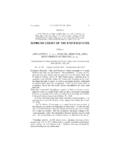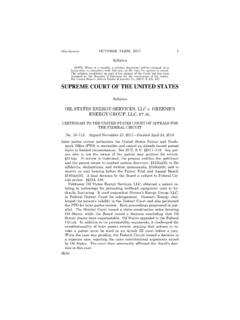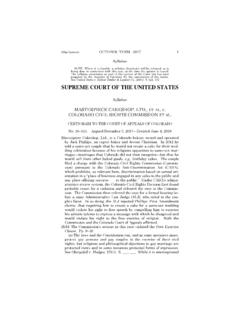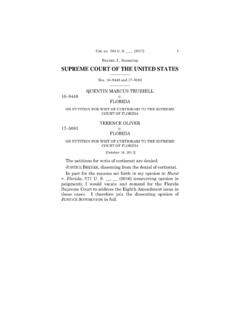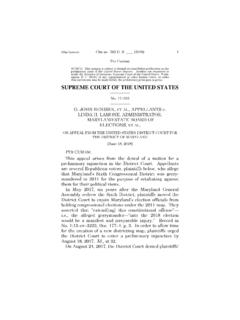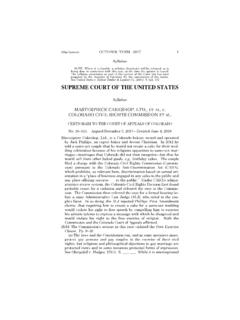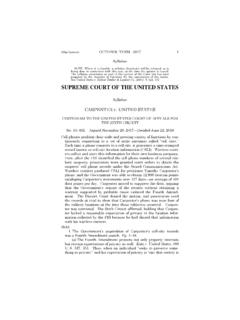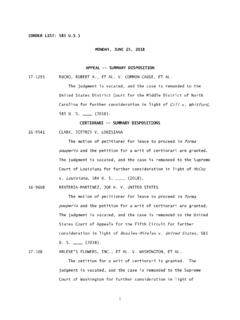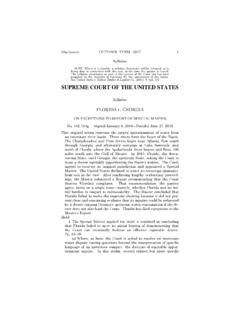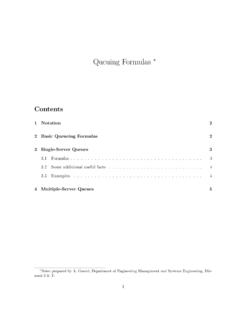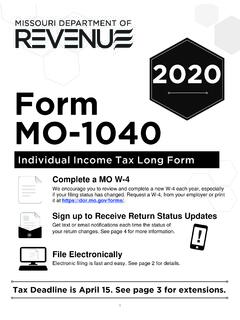Transcription of SUPREME COURT OF THE UNITED STATES
1 1 (Slip Opinion) OCTOBER TERM, 2020 Syllabus NOTE: Where it is feasible, a syllabus (headnote) will be released, as is being done in connection with this case, at the time the opinion is issued. The syllabus constitutes no part of the opinion of the COURT but has been prepared by the Reporter of Decisions for the convenience of the reader. See UNITED STATES v. Detroit Timber & Lumber Co., 200 U. S. 321, 337. SUPREME COURT OF THE UNITED STATES Syllabus LANGE v. CALIFORNIA CERTIORARI TO THE COURT OF APPEAL OF CALIFORNIA, FIRST APPELLATE DIVISION No. 20 18. Argued February 24, 2021 Decided June 23, 2021 This case arises from a police officer s warrantless entry into petitioner Arthur Lange s garage.
2 Lange drove by a California highway patrol officer while playing loud music and honking his horn. The officer be-gan to follow Lange and soon after turned on his overhead lights to signal that Lange should pull over. Rather than stopping, Lange drovea short distance to his driveway and entered his attached garage. The officer followed Lange into the garage. He questioned Lange and, after observing signs of intoxication, put him through field sobriety tests. A later blood test showed that Lange s blood-alcohol content was three times the legal limit. The State charged Lange with the misdemeanor of driving under theinfluence. Lange moved to suppress the evidence obtained after the officer entered his garage, arguing that the warrantless entry violatedthe Fourth Amendment.
3 The Superior COURT denied Lange s motion, and its appellate division affirmed. The California COURT of Appeal also affirmed. It concluded that Lange s failure to pull over when theofficer flashed his lights created probable cause to arrest Lange for themisdemeanor of failing to comply with a police signal. And it stated that Lange could not defeat an arrest begun in a public place by re-treating into his home. The pursuit of a suspected misdemeanant, thecourt held, is always permissible under the exigent-circumstances ex-ception to the warrant requirement. The California SUPREME COURT denied review. Held: Under the Fourth Amendment, pursuit of a fleeing misdemeanor suspect does not always that is, categorically justify a warrantless entry into a home.
4 Pp. 3 16.(a) The COURT s Fourth Amendment precedents counsel in favor of a 2 LANGE v. CALIFORNIA Syllabus case-by-case assessment of exigency when deciding whether a sus-pected misdemeanant s flight justifies a warrantless home entry. The Fourth Amendment ordinarily requires that a law enforcement officerobtain a judicial warrant before entering a home without permission. Riley v. California, 573 U. S. 373, 382. But an officer may make a warrantless entry when the exigencies of the situation, considered in a case-specific way, create a compelling need for official action and notime to secure a warrant.
5 Kentucky v. King, 563 U. S. 452, 460; Mis-souri v. McNeely, 569 U. S. 141, 149. The COURT has found that such exigencies may exist when an officer must act to prevent imminentinjury, the destruction of evidence, or a suspect s escape. The amicus contends that a suspect s flight always supplies the exi-gency needed to justify a warrantless home entry and that the Courtendorsed such a categorical approach in UNITED STATES v. Santana, 427 U. S. 38. The COURT disagrees. In upholding a warrantless entry made during a hot pursuit of a felony suspect, the COURT stated that San-tana s act of retreating into her house could not defeat an arrest that had been set in motion in a public place. Id.
6 , at 42 43. Even assuming that Santana treated fleeing-felon cases categorically, that statement still does not establish a flat rule permitting warrant- less home entry whenever a police officer pursues a fleeing misde-meanant. Santana did not resolve the issue of misdemeanor pursuit; as the COURT noted in a later case, the law regarding warrantless en-try in hot pursuit of a fleeing misdemeanant is not clearly es-tablished one way or the other. Stanton v. Sims, 571 U. S. 3, 8, 10. Misdemeanors run the gamut of seriousness, and they may be mi-nor. STATES tend to apply the misdemeanor label to less violent and less dangerous crimes. The COURT has held that when a minor offense (and no flight) is involved, police officers do not usually face the kindof emergency that can justify a warrantless home entry.
7 See Welsh v. Wisconsin, 466 U. S. 740, 742 743. Add a suspect s flight and the cal-culus changes but not enough to justify a categorical rule. In many cases, flight creates a need for police to act swiftly. But no evidence suggests that every case of misdemeanor flight creates such a need. The COURT s Fourth Amendment precedents thus point toward as-sessing case by case the exigencies arising from misdemeanants flight. When the totality of circumstances shows an emergency a need to act before it is possible to get a warrant the police may act without wait-ing. Those circumstances include the flight itself. But pursuit of amisdemeanant does not trigger a categorical rule allowing a warrant-less home entry.
8 Pp. 3 12.(b) The common law in place at the Constitution s founding similarlydoes not support a categorical rule allowing warrantless home entry whenever a misdemeanant flees. Like the COURT s modern precedents, 3 Cite as: 594 U. S. ____ (2021) Syllabus the common law afforded the home strong protection from government intrusion and it generally required a warrant before a government of-ficial could enter the home. There was an oft-discussed exception: An officer, according to the common-law treatises, could enter a house to pursue a felon. But in the misdemeanor context, officers had more limited authority to intrude on a fleeing suspect s home. The commen-tators generally agreed that the authority turned on the circum-stances; none suggested a rule authorizing warrantless entry in everymisdemeanor-pursuit case.
9 In short, the common law did not have and does not support a categorical rule allowing warrantless home entry when a suspected misdemeanant flees. Pp. 12 16. Vacated and remanded. KAGAN, J., delivered the opinion of the COURT , in which BREYER, SO-TOMAYOR, GORSUCH, KAVANAUGH, and BARRETT, JJ., joined, and in which THOMAS, J., joined as to all but Part II A. KAVANAUGH, J., filed a concur-ring opinion. THOMAS, J., filed an opinion concurring in part and concur-ring in the judgment, in which KAVANAUGH, J., joined as to Part II. ROB-ERTS, C. J., filed an opinion concurring in the judgment, in which ALITO, J., joined. _____ _____ 1 Cite as: 594 U. S. ____ (2021) Opinion of the COURT NOTICE: This opinion is subject to formal revision before publication in the preliminary print of the UNITED STATES Reports.
10 Readers are requested to notify the Reporter of Decisions, SUPREME COURT of the UNITED STATES , Wash-ington, D. C. 20543, of any typographical or other formal errors, in order that corrections may be made before the preliminary print goes to press. SUPREME COURT OF THE UNITED STATES No. 20 18 ARTHUR GREGORY LANGE, PETITIONER v. CALIFORNIA ON WRIT OF CERTIORARI TO THE COURT OF APPEAL OF CALIFORNIA, FIRST APPELLATE DISTRICT [June 23, 2021] JUSTICE KAGAN delivered the opinion of the COURT . The Fourth Amendment ordinarily requires that police officers get a warrant before entering a home without per-mission. But an officer may make a warrantless entrywhen the exigencies of the situation create a compelling law enforcement need.
